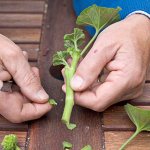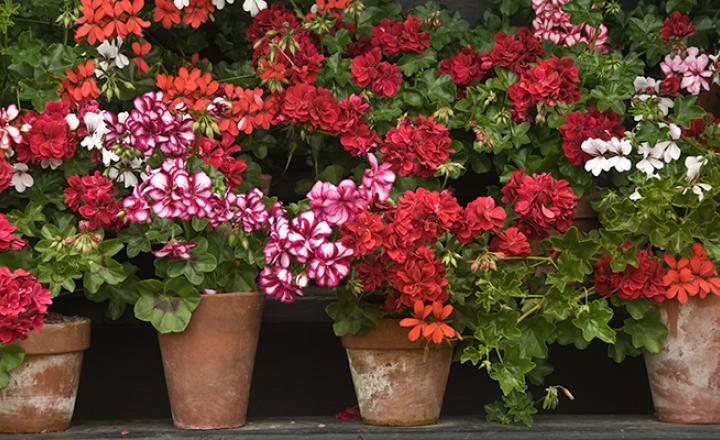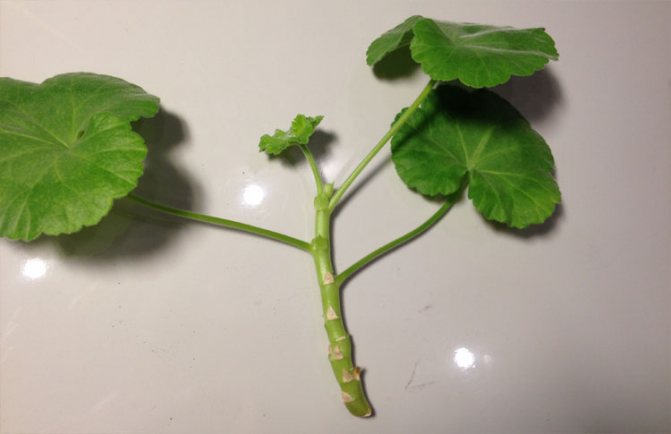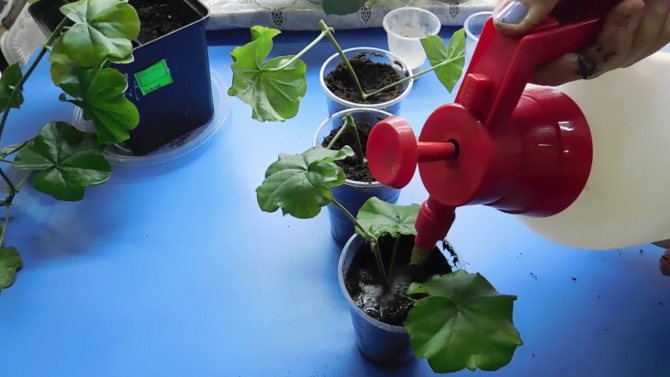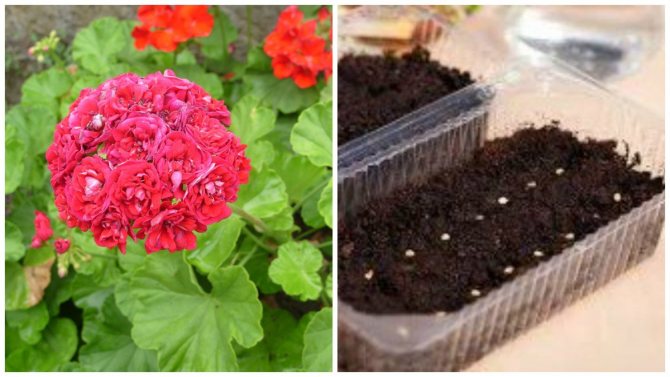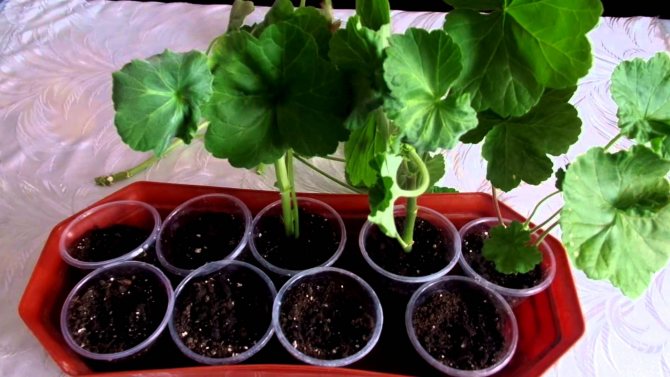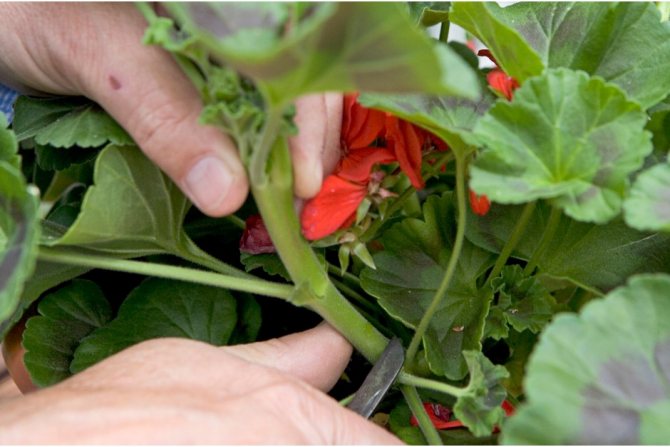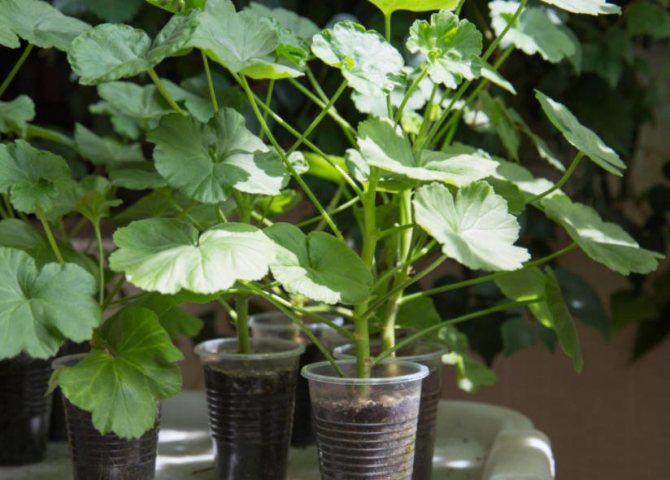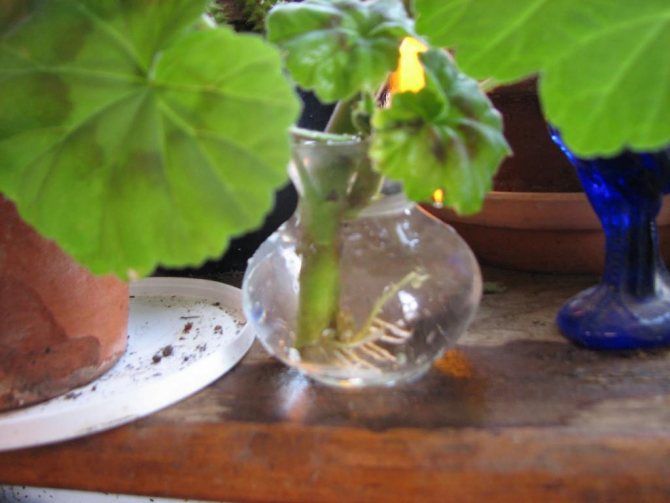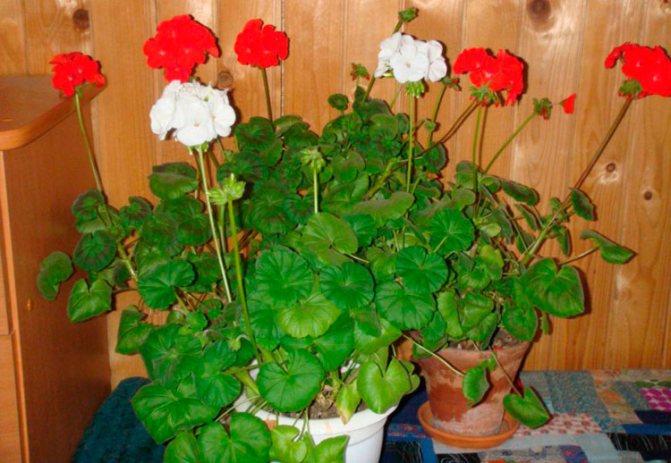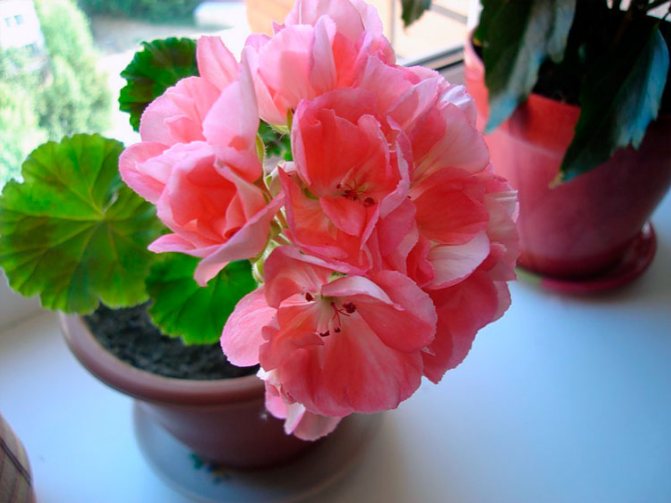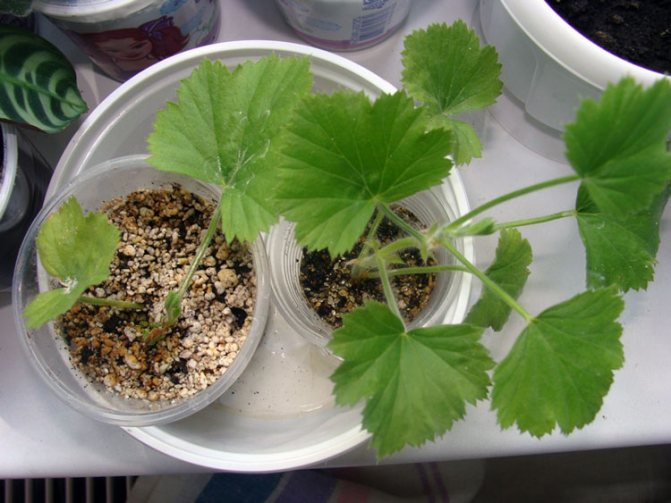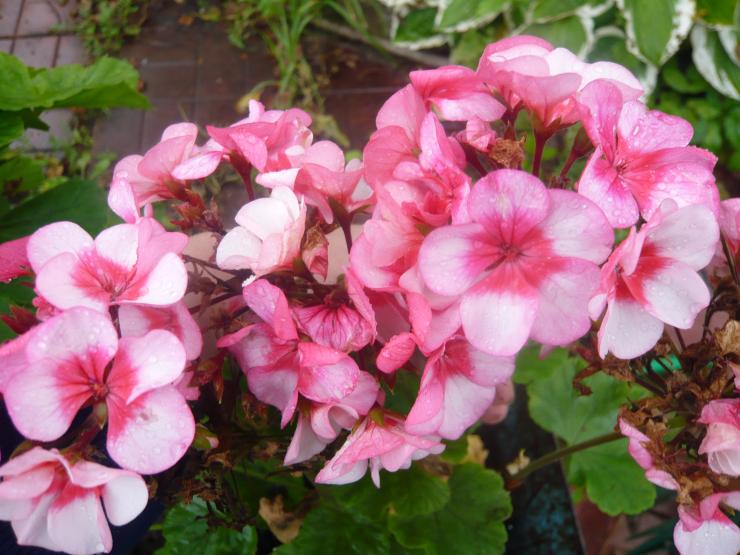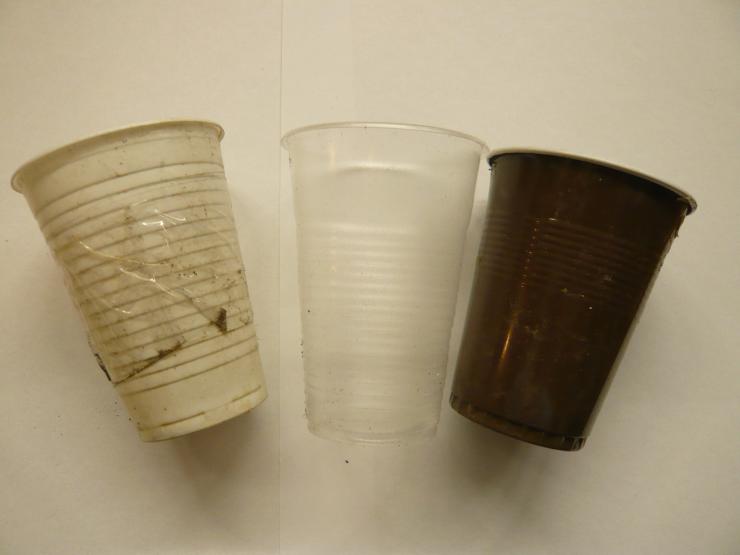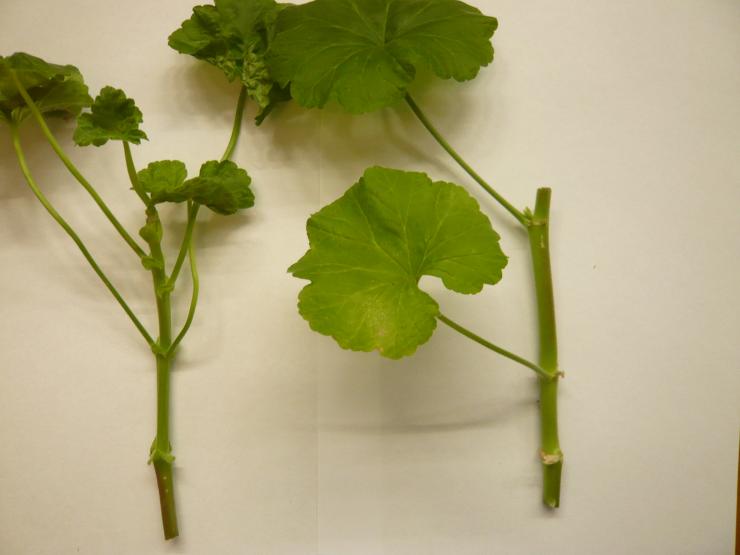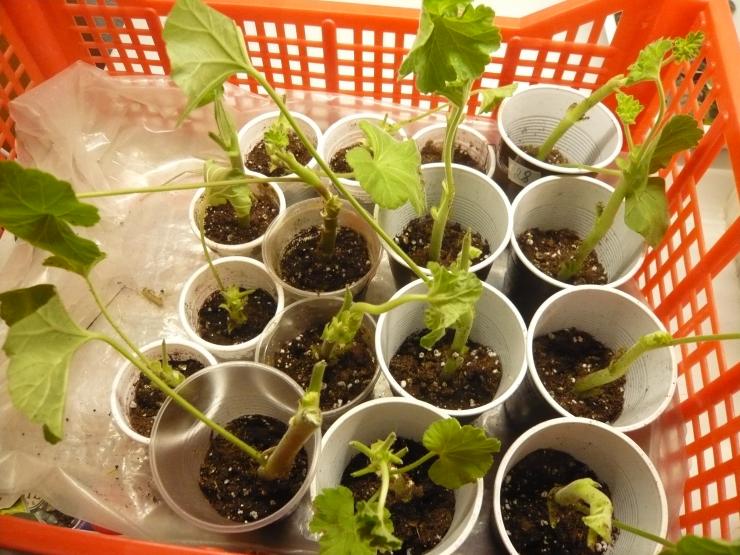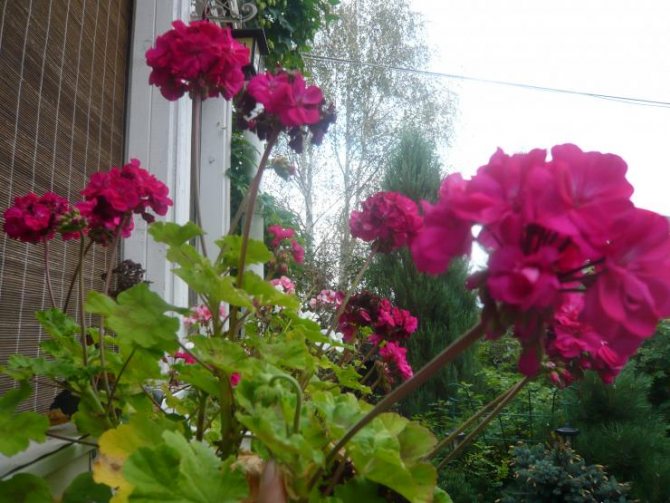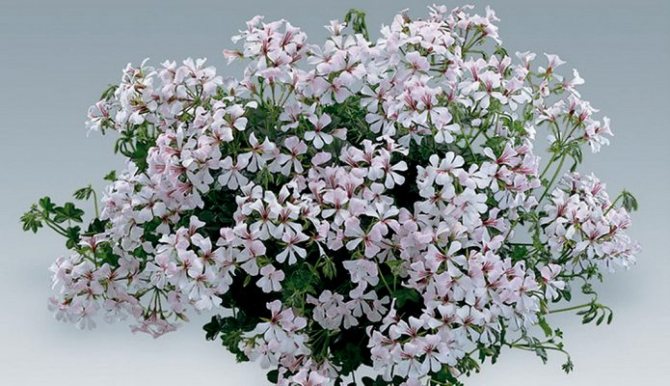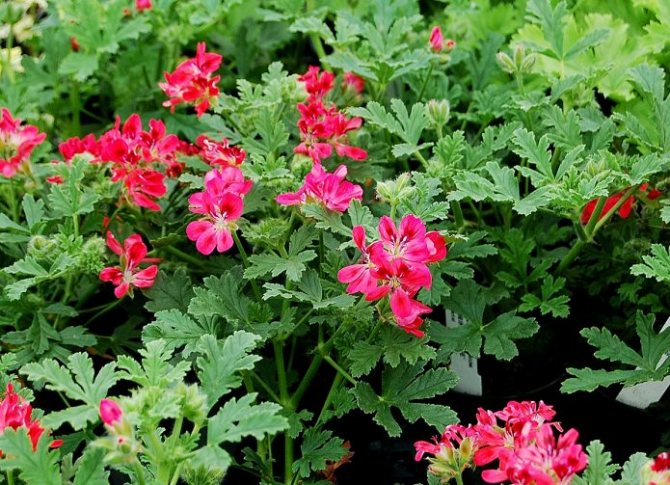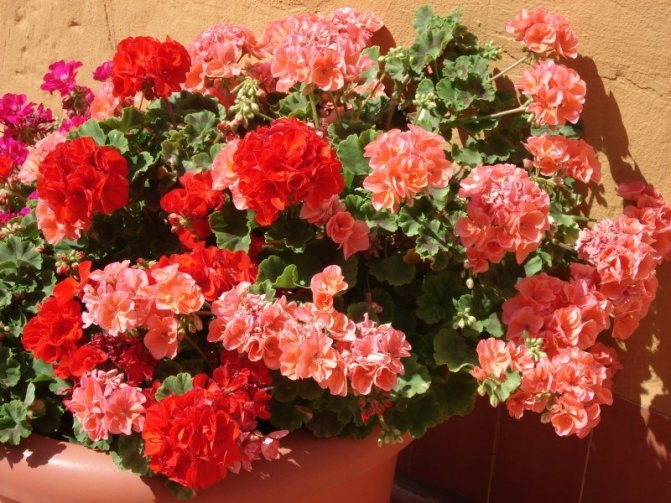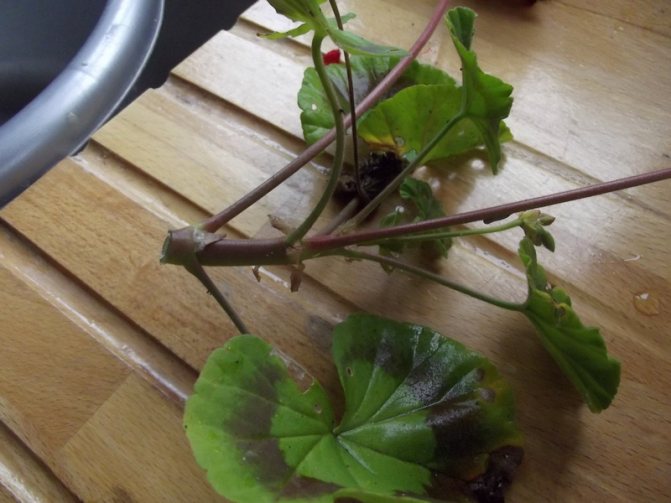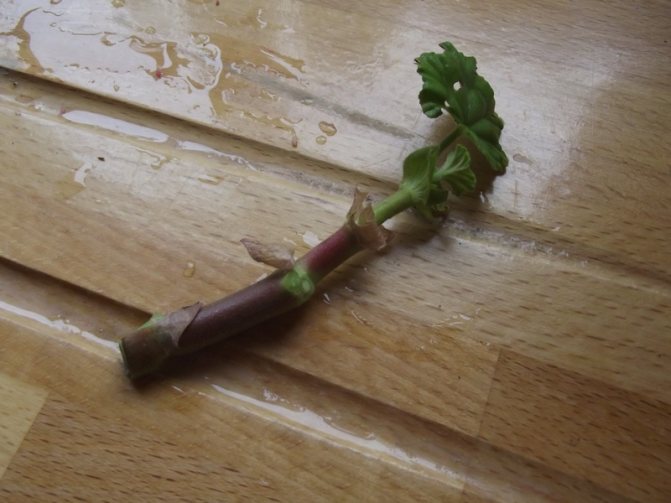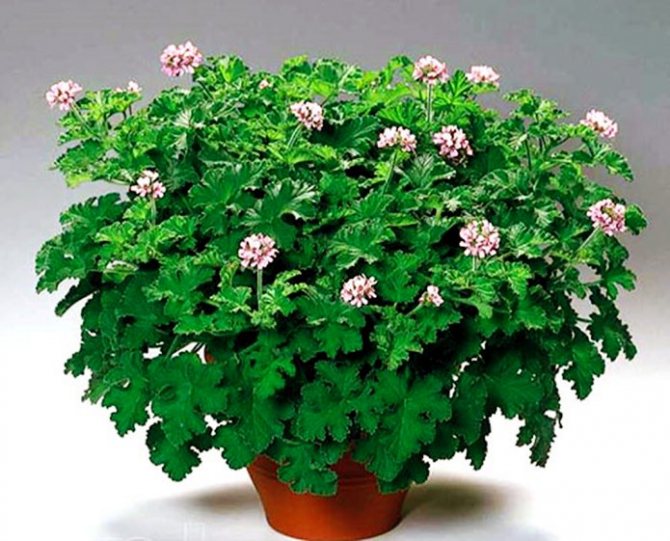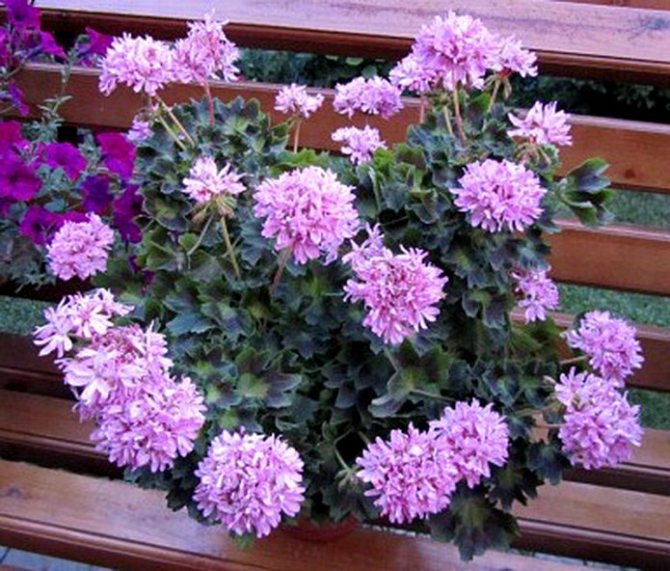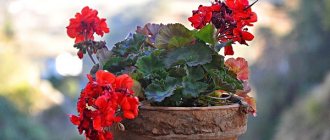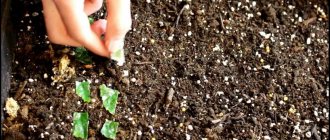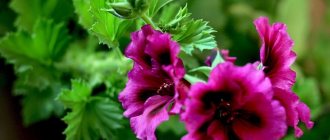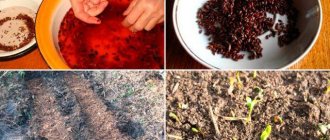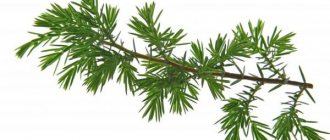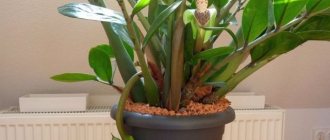Reproduction methods
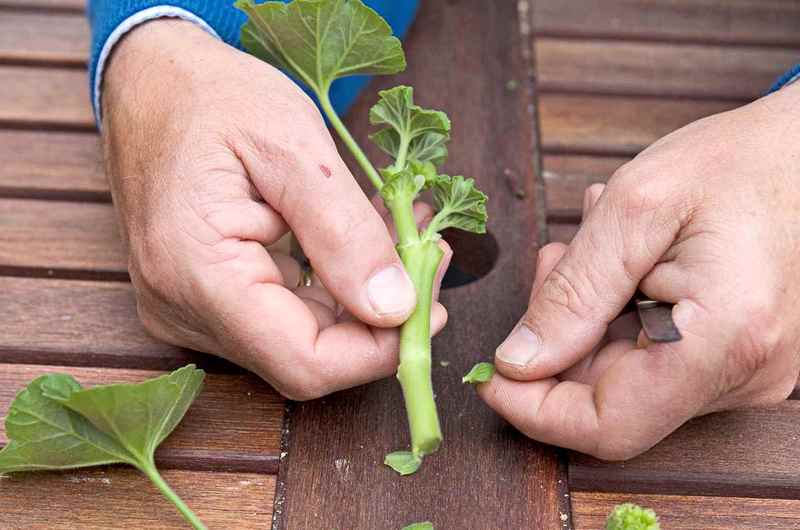
Pelargonium first appeared in European countries in the 17th century and immediately became very popular. Breeders tirelessly develop new varieties and now their number has exceeded 400. The greatest demand among flower growers is for large-flowered, zonal, fragrant, thyroid, unique and angel geraniums.
Pelargonium reproduces:
- seeds;
- stem cuttings;
- dividing the bush.
Seed cultivation is the most laborious process; in this case, the characteristics of the maternal geranium variety are not always preserved. Dividing an adult bush is more often practiced when transplanting a plant to a new location.
Important!
It is faster and easier to propagate geranium by cuttings at home. When propagated by cuttings, young plants bear all the characteristics of the parent's variety.
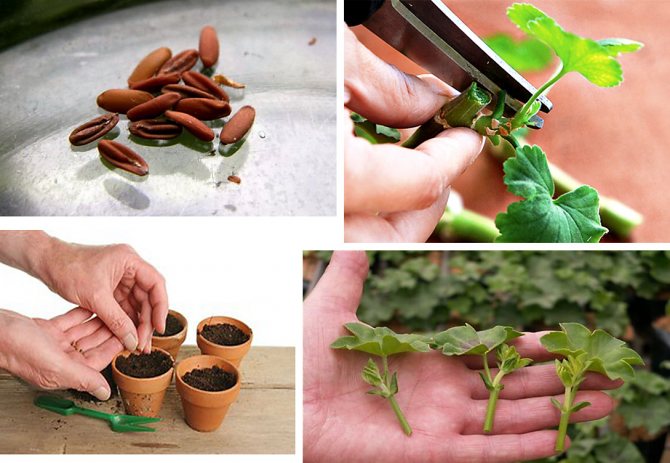

Zonal geranium develops best when cuttings. Young plants bloom within 3 months after planting cuttings. In other species, this process is much slower. They are ready to bloom only 6-15 months after grafting.
Another purpose of cuttings is to rejuvenate the adult plant. If this is not done, after a few years a beautiful, strong plant will turn into an elongated bare stem with few inflorescences at the ends of the shoots.
Can you plant like that?
Due to the ability of geraniums to survive and continue to grow even in unfavorable conditions for this, it can be propagated without using roots. But in general there are three ways to propagate this culture:
- seeds;
- dividing the roots;
- by cuttings.
The first method takes too much time and patience, because in order to germinate seeds, you need to provide strictly defined conditions, the second is rather risky, since delicate roots in the process of dividing it is very easy to damage, but the third, cuttings, is preferred by most people involved in the cultivation and breeding of geraniums.
The main advantage of this method is the ability to propagate the plant without touching its roots, which guarantees the complete safety of the mother plant.
Duration of cuttings
All procedures involving mechanical damage to the plant are carried out taking into account the annual cycle and biological characteristics of the species. Otherwise, the survival rate of pelargonium worsens, varietal characteristics are lost, and immunity to diseases decreases.
Cuttings taken from old pelargonium take root much worse. With age, the ability to form roots decreases due to a decrease in water-retaining properties and slow metabolic reactions. Therefore, with the timing of cuttings, it is better not to delay.
Pelargonium cuttings are cut in autumn and spring. Although some nurseries commercially cut geraniums all year round, including in winter, it is optimal to do this in August-September or March-April.
Cuttings taken in spring have more chances of successful rooting. These include a consistently high temperature, the absence of drafts, the right amount of sunlight required for the synthesis of auxin. The disadvantage of the spring procedure is that the planting material is cut with already formed flower buds. This reduces the decorative effect of the mother bush.
Autumn pelargonium goes into a dormant stage and the rate of metabolic reactions is reduced. Therefore, the propagation of geraniums by cuttings in the fall at home is a little more difficult and slower if the shoots are cut from a bush over 6 years old. Planting material from young pelargonium develops quickly and blooms next year.
Important!
Cutting cuttings and rooting are performed in the same way for all types of pelargonium. Rooting of royal pelargonium is carried out only in the soil due to its tendency to rot due to the accumulation of moisture. The rest of the species are rooted in soil or water.
Everyone's favorite geranium
Like many popular plants, pelargonium came to us from South Africa. And soon it became the beloved Russian geranium, with the same diligence decorating both the narrow window of the village hut and the wide city window sill. Planted on the street, it is a wonderful decoration for any flower bed. In any flower arrangement, geranium successfully takes its rightful place. The development of breeders has made it possible to create numerous hybrids and varieties that differ in the shape, color of leaves and inflorescences.
Important to know: geranium needs replanting every 3 years. If the plant is not renewed, it loses its attractiveness over time: the bush grows densely, the stems become woody, and the abundance of flowering decreases.
Royal, zonal, fragrant, ivy - the main types of pelargonium
- Royal pelargonium is valued for its large inflorescences, which reach a diameter of 15 cm, and the petals of this plant are of different shapes and shades. Cuttings of royal geraniums are carried out according to general principles, but this should be done only in spring or summer. In winter, the plant requires rest and should be stored in a cool, bright room at 15 degrees.
- Zonal pelargonium is prized for its long flowering, which can last almost all year round. The plant is famous for its durability and may not lose its decorative effect for up to 20 years. It is best and fastest to root a stalk of zoned pelargonium in a mixture of sand and peat or perlite.
- Varieties of scented geranium can differ in color of flowers and shades of smell. The most successful reproduction of this species occurs by cutting the plant in water or dividing the bush in early spring.
- Trumpet geranium (or ivy, ivy) is of interest when grown in hanging pots. The plant bushes well, blooms profusely all summer, its branches can reach a length of 70–90 cm. Reproduction is preferably carried out by grafting: the shoot will root well in the substrate if the soil is constantly moist. It is better to prepare the soil for the rooted cuttings from a mixture of peat, sand, humus and leafy soil. It is imperative to lay expanded clay at the bottom of the flower dishes.
Photo gallery: a cascade of shapes and colors
Harvesting cuttings
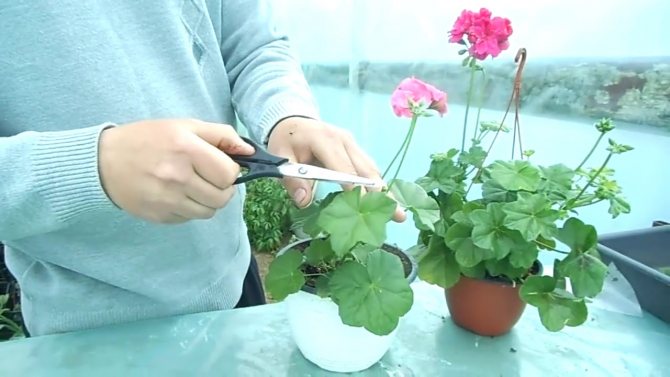

For better survival, uterine bushes are selected and cuttings are cut, guided by the following rules:
- healthy and strong pelargoniums are suitable for reproduction;
- cuttings are cut from the top of the bush;
- for work, a sharpened knife with a disinfected blade is used;
- cut cuttings 8 cm long with 2-3 internodes oblique cut;
- if the stem is long, 2 cuttings are cut from it, making the upper cut just above the bud;
- the stump over the kidney is made minimal so as not to provoke rotting;
- the leaves are cut off from below, leaving from 3 to 5 leaves on the stem;
- all flower stalks with buds are plucked to improve survival.
What is a stalk, how to choose and prepare it correctly?
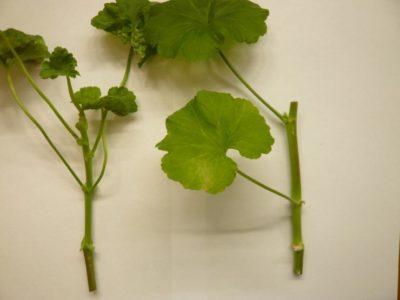

A shoot, or stalk, is a cut off part of a plant with one or more nodes. This cut off part is just the same used for vegetative propagation (cuttings). In order to get a new geranium, completely identical to the previous one, you first need to choose this stalk.
When should you take a stalk from a mother flower in order to plant and grow a young plant? The mother plant should be well developed and completely healthy, ideally 2 to 3 years old. It is necessary to choose the apical cuttings of the mother geranium. In length, this process should be 7 - 8 cm, have one or more nodes (buds, growth points) and 3 - 5 leaflets. If leaves remain at the base of the cutting, they must be carefully removed.
If the branches of the appendix are the same length as itself, then it is imperative to cut them off, and then you can use them as independent cuttings. And the finished shoots are left in the air so that the cut sites dry out. If after a few hours they are tightened with a thin film, it means that everything went well and the cuttings are ready for the next stage.
Preparation of planting material for rooting
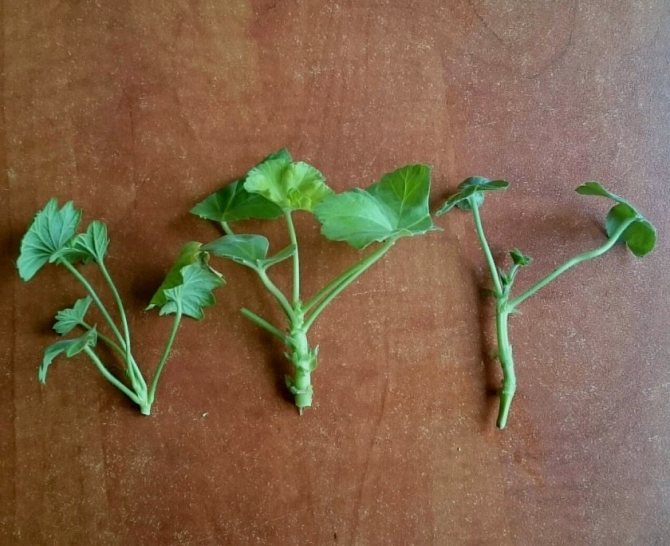

Usually, cuttings of pelargonium take root well without any preparation, but to increase the chances of favorable reproduction, several activities are carried out:
- After cutting, the cuttings are laid out on a flat surface in a darkened room for 2-3 hours to dry.
- The dried sections are treated with crushed activated carbon, wood ash, or Kornevin. Also do with cuts on the mother bush.
- Before planting, an additional cut of the cutting is treated with a root stimulator.
How to propagate geraniums at home by cuttings (step by step preparation)?
Here is an approximate procedure for selecting planting material for pelargonium:
- Examine the mother plant carefully, select the most suitable stem tips for cutting.
- Take a sharp knife or blade and carefully cut the stem from the donor plant. You can cut the shafts up to 10 cm long. Cut between two adjacent leaves.
- Do not send the cuttings directly to the pot, let them dry. Do this at normal room temperature.
- After the sections have dried on the plant and a thin film has formed, treat these places with ash or absorbent.
- Tear off the lower leaves of the petioles, it is enough to leave 2-3 leaves. Do the same with the buds at the tops, if any.
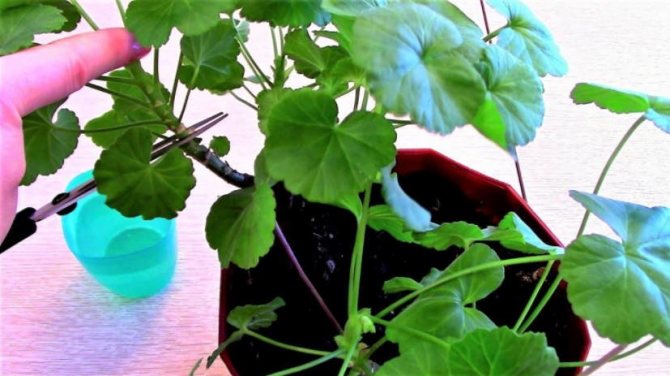

Rooting in water
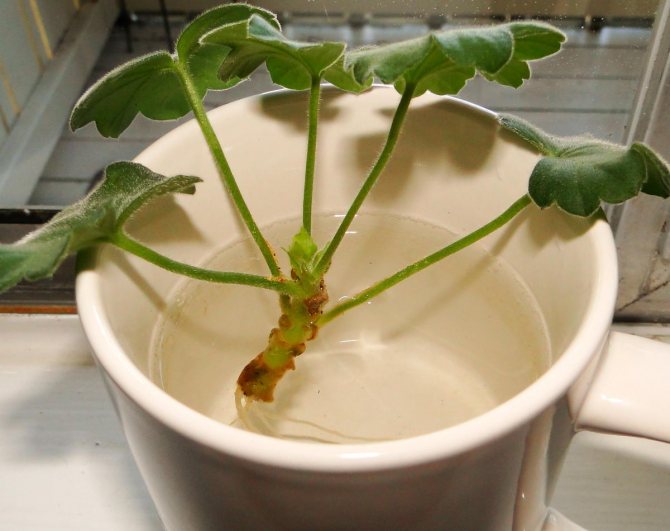

This method of grafting pelargonium is the simplest. For root growth, cut cuttings are dipped in containers with clean water, deepening the lower end by 2-3 cm, so as not to reduce the useful breathing area of the appendix. For disinfection, powder from a crushed tablet of activated carbon is added to the glasses. This will prevent the cuttings from rotting.
Important!
The water is changed weekly. If the liquid level in the glass drops rapidly due to strong evaporation, it is simply topped up.
In the room where rooting takes place, the temperature is maintained from +14 to +16 degrees. At lower temperatures, the scion will not release roots and will rot. After 7-10 days, roots appear on the lower cut. After half a month, they grow to a sufficient length and the young plant is moved into the ground. Then the seedling is looked after in the usual way.
Reproduction: ampelous geranium, or pelargonium
In order for the windowsill to bloom for three seasons, you need to carefully care for the plant and plant it correctly. If there is a desire to propagate geraniums of various types (pelargonium, as it is also called), you need to know a few simple rules:
- you can grow a seedling using seeds or cuttings. Prefers ivy geranium propagation by cuttings according to the same principle as ampelous;
- the plant loves saturated soil, slightly clayey, from several components;
- you can plant sprouts in the garden. But it is worth planting cuttings in the ground, taking into account certain conditions of care.
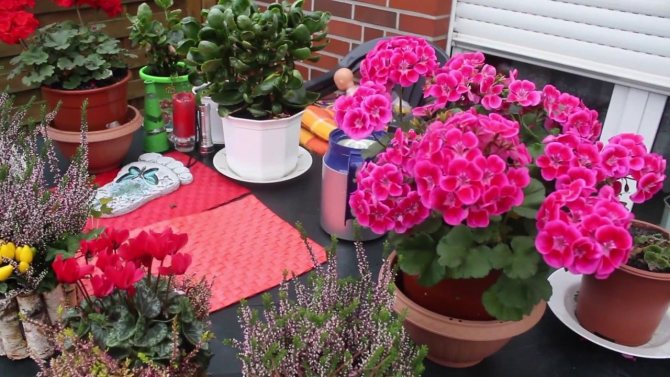

Unique flower with bright buds
In order for the sprouts to take root, it is desirable to have a certain stock of knowledge and be able to work with the land. It is necessary to think over each step of action. Any grower can choose his own method regarding how to propagate pelargonium.
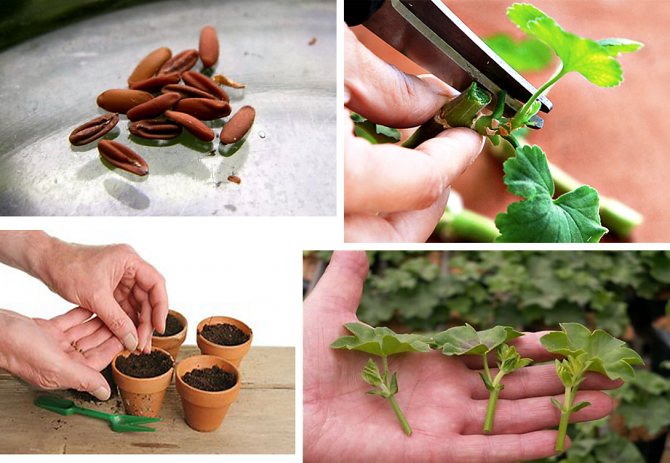

Geranium breeding methods
Rooting in the ground
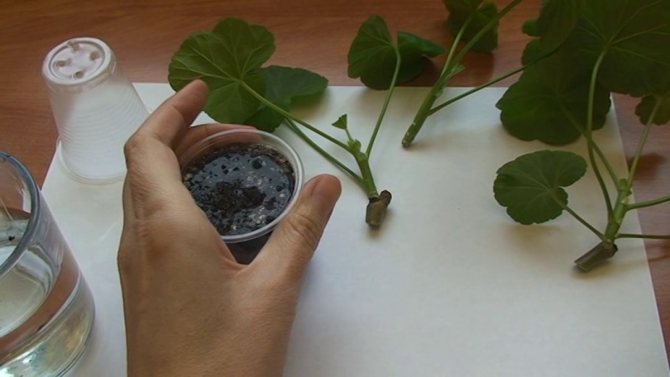

For most varieties of geraniums, planting the cuttings directly into the substrate is often used. For rooting, different options for soil mixtures are applicable:
- independently mixed soil from identical parts of garden soil with neutral acidity, humus, sand and turf;
- soil mixture from ready-made universal soil for indoor flowers with the addition of sand and vermiculite;
- coconut substrate;
- a mixture of equal amounts of perlite and peat;
- sphagnum;
- ready-made peat tablets.
For planting cuttings, take small pots, disposable cups or other suitable containers with a volume of 100-200 ml. Be sure to make holes at the bottom and lay a drainage layer. The selected soil is placed in disinfected containers and spilled with boiling water or a pinkish solution of potassium permanganate.
In the center of the pot, a hole 3 cm deep is made in the substrate and the lower cut of the prepared cutting is placed in it. Then sprinkle with soil and compact. Containers with planted cuttings are installed on a well-lit windowsill, shading from direct sunlight. At the time of rooting, the temperature in the room is maintained from +18 to +25 degrees.
During rooting, the cuttings are moderately watered. Drying out or waterlogging of the soil must not be allowed. When watering, water should not be on the leaves. The signal of successful rooting is the regrowth of new leaves on the cuttings. Then you can transplant the young plant into a permanent pot.
Important!
When planting cuttings, it is convenient to place them in pots one at a time. If you need to plant several specimens in one container, a distance of 3 cm is observed between them so that the roots of the plants do not intertwine together.
How to carry out the procedure?
The cut off shoots do not yet have roots, which are necessary for the development of a full-fledged geranium, therefore, after their preparation, it is necessary to root the cuttings. This can be done in water or directly in the finished substrate.
Rooting cuttings in water
How to propagate a plant by placing the cuttings in water? The main advantage of this method is the ability to observe the process from start to finish and not miss the moment when the shoot will have roots and it can already be planted in the substrate.
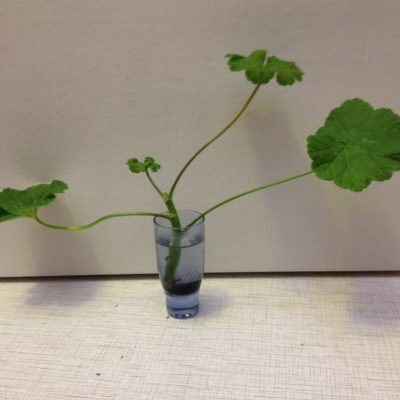

Prepare a small transparent container (disposable cups are great).- Pour settled water at room temperature into the container up to about half a glass (5 cm).
- Dip the scions into the water.
- Change the water every 2 days.
- After about a week (during this period the first roots should appear), transplant the rooted cutting into the prepared substrate in a container of a suitable size.
Rooting in water also has its significant disadvantage: sometimes rotting of the cutting can occur even before it takes root, and in order to prevent this, flower growers strongly recommend adding crushed activated carbon to it every time you change water for disinfection.
Using this method, you can get beautiful and healthy geraniums.
Rooting in the ground
Is it possible to plant a stalk without roots directly into the ground? Thanks to rooting in the ground, you can not be afraid of rotting of the processes, as this happens extremely rarely, but you will not be able to see when the roots appear, which sometimes spoils the planting material by the fact that it is transplanted ahead of time. How to plant correctly can be read in the instructions:
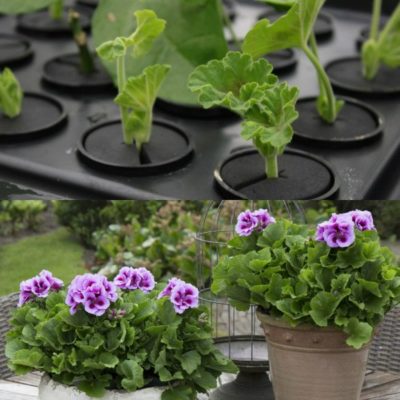

Prepare a substrate from garden soil and peat.- Place prepared soil in a small container, moisturize abundantly and compact well.
- Choose a location with adequate ambient lighting. Cuttings do not like scorching rays very much.
- Place the scion in the substrate at a depth of 4 - 5 cm and re-compact the earth around it.
- Waiting for new leaves to appear on the handle means that it has successfully taken root and is ready to be transplanted into a full-fledged pot. It will take about a month.
Reproduction in a greenhouse
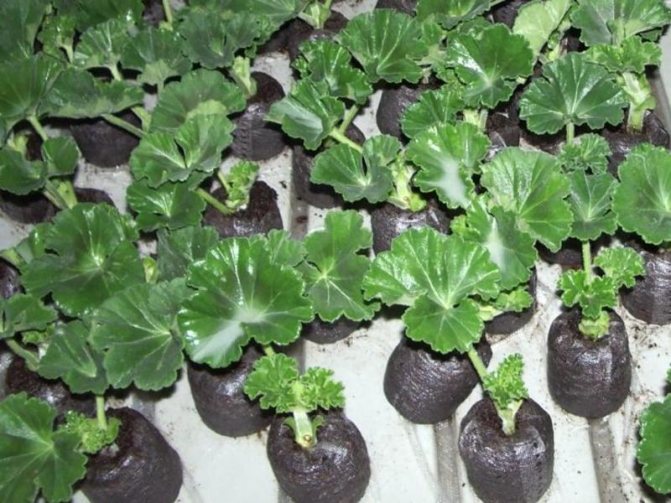

Growers engaged in mass cultivation of geraniums often use mini-greenhouses for rooting cuttings. Such a device is a wide container with soil, covered with glass or film. The greenhouse speeds up the rooting process and allows you to work with several cuttings at the same time and save space on the windowsill. Such a greenhouse can be built independently from improvised items or purchased ready-made.
The greenhouse pan is filled with nutritious soil, several cuttings are planted in it and covered with a lid. The soil in the greenhouse is irrigated regularly so that it does not dry out. It is impossible to fill in the soil, otherwise the cuttings will rot. 2 weeks after the start of rooting, the lid is removed.
The period of root formation for all pelargoniums is different. So, the royal one takes root in a month, and the ivy geranium needs only 2 weeks. Successful rooting is indicated by young leaves that have grown on the handle. After their appearance, the seedling is transferred to a permanent container. This is done by transferring the plant along with an earthen clod.
Homemade pelargonium in the photo
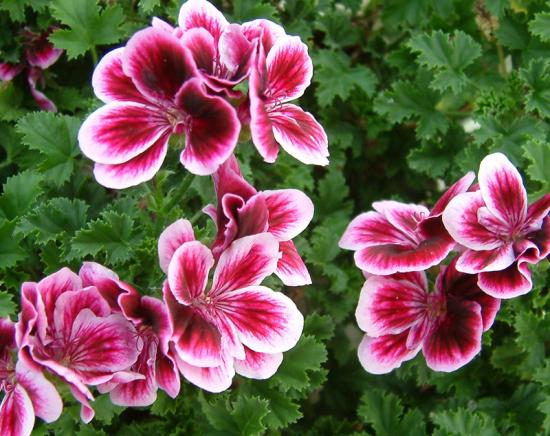

If there is a darkening of the stem, then this is a clear sign of a black leg lesion. Occurs when there is an excess of moisture. Another common problem is gray mold on the leaves. You can get rid of a fungal disease with a fungicidal agent.
Yellow spots on the leaves are a sign of rust damage. If you follow the rules for caring for pelargonium cuttings, you can achieve abundant and beautiful flowering.
Transfer
Pelargoniums are grown in pots with a volume of no more than 0.75 liters. Too large capacity of the container provokes the plant to build up the root system and green mass. This reduces flowering rates. For the same reason, geraniums are not fed with nitrogen fertilizers. The selected pot at the bottom must have holes. It is filled with 15% expanded clay drainage.
For the growth of geraniums, a soil mixture is suitable, consisting of:
- 2 parts of sod land;
- 1 part peat;
- 1 part sand.
The prepared soil is watered with a weak solution of potassium permanganate for disinfection and structuring, and then two-thirds of the prepared pot is filled with it. Then the rooted cutting is transferred to a pot. It is advisable to do this by transshipment, so as not to disturb the root system once again. The remaining space is filled with soil, occasionally shaking the container to avoid the formation of voids. Then the flower is watered with lukewarm, previously settled water.
Important!
Ivy geranium looks especially advantageous in group planting. In this case, the plants are planted in a long container, observing an interval of 15 cm between them.
When to cuttings?
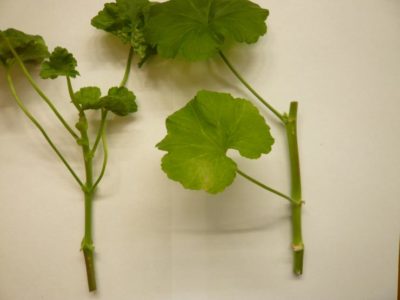

In order to breed a plant, it is important to know not only how to properly cut geraniums, but also when it is better to do it. In theory, geranium cuttings can be harvested all year round.
But for successful rooting, it is better to carry out the procedure from the end of February to the end of March, when the plant begins to actively move the plant juices. Geraniums from such cuttings will flower at the end of summer. You can also propagate in late August or early September, this is the time when geraniums have not yet dormant. Such a plant will bloom next year.
Care of young plants
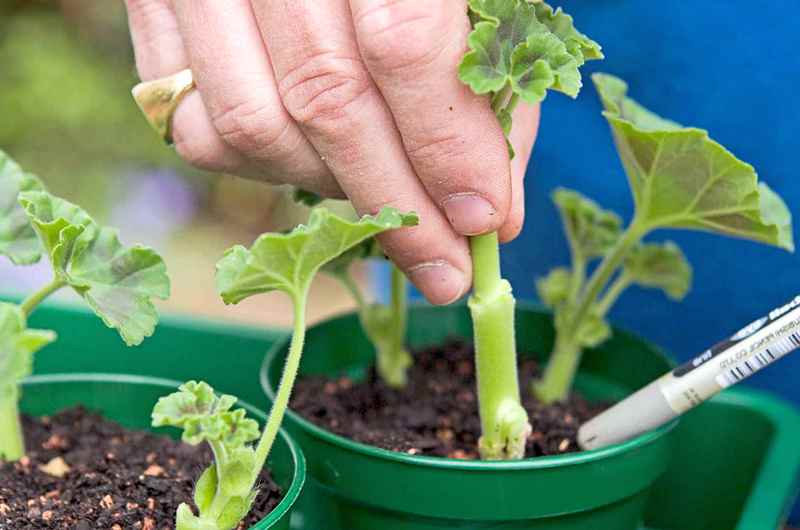

Young geraniums are looked after in the same way as adult plants. Pots with bushes are installed on southern windowsills with good lighting or light partial shade. In a particularly hot time of the day, geraniums are shaded so that the sun's rays do not burn the leaves.
In the hot season, geraniums are often watered. The amount of winter watering is reduced to 1-2 times a week. It depends on the type and condition of the air in the room. Additional moistening in the form of spraying or sprinkling of pelargonium is not needed. Regularly loosen the soil in containers and remove withered leaves and faded buds.
Important!
When the period of winter dormancy begins, pelargonium is moved to a cooler room with a temperature of +8 to +12 degrees. You can simply move the pots closer to the window pane.
To activate growth and provoke geraniums to bloom, they feed it with mineral complexes with a small amount of nitrogen twice a month in spring and summer. To make the bush more lush, pinch the top of the geranium and several side shoots.
Don't make mistakes, be mindful of geranium problems
For most flower growers, grafting of pelargonium is not difficult. If it is carried out with high quality, then this will immediately affect the appearance of the flower. Unfortunately, sometimes pelargonium is subject to certain diseases. It does not hurt you to know about the main problems of this perennial:
- Sometimes the lower leaves turn yellow. With a lack of moisture, only the edges dry out. Waterlogging leads to complete drying of the leaf.
- There are cases of reddening of the edges of the leaves. This is a signal that the plant is cold. In winter, move the flower pot away from the window.
- If the stem turns dark at the base, then it is struck by a black leg. It will not be possible to save such a plant. It will also not reproduce. What is the reason? Possibly in dense and overly damp ground.
- Lack of light leads to exposure of the stems.
- Rarely, mold can develop on the leaves. This phenomenon is associated with a fungal disease caused by excessive moisture. In this case, you need to remove the affected parts, treat the rest of the plant with a fungicide.
From all of the above, we can conclude that there is nothing difficult in breeding and caring for geraniums. You only need to correctly calculate the time of grafting and harvesting of planting material. Responsibly treat the selection of soil for rooting and transplanting. All our recommendations will help you grow independently blooming beauties that will become a real decoration of your home and garden.
Tips & Tricks
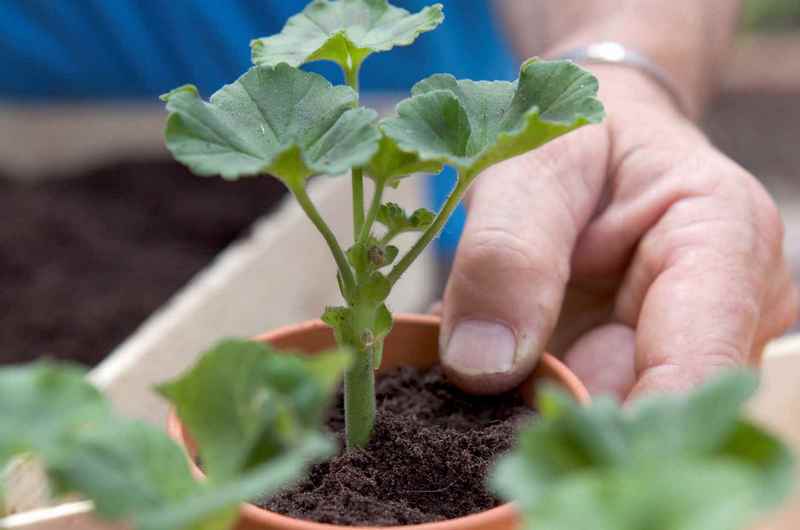

In order for grafting to be successful, florists with extensive experience advise:
- a few days before cutting the cuttings, stop watering the mother bush;
- to protect against fungus, cover the planted cuttings with plastic bags or glass jars for 2 days;
- for planting cuttings, use small pots or place several pieces in flowerpots;
- do not use clay pots with a porous structure for growing geraniums, as they provoke moisture evaporation;
- in summer, transplant geraniums to a garden on a flower bed or simply take out the pots to the open air.
Types and preferences of the plant
Most often, the following 4 types of geraniums are planted in pots:
- Ampelny or curly. Placed in hanging pots near windows or front doors of the house.
- Fragrant. It grows as a lush bush with small leaves and flowers, emits a pleasant aroma.
- Royal. A tall bush with large, bright flowers. Can be plain or terry.
- Zonal. Propagated most often. It is distinguished by multi-colored circles on the leaves.
All of the listed types of pelargonium have their own predilections. Most of all, this perennial loves timely watering, the correct selection of place and soil, fresh air. Pelargonium growing in a pot in the warm season is best defined on a balcony, terrace or garden. In winter and autumn, one should not forget about airing the room.This will help the plant fight fungal diseases.
Further you will learn more about how you can breed geraniums yourself at home, except for dividing the bush.
How to plant a geranium with a shoot: ways
You can cut cuttings for reproduction at any time of the year, however, in the cold months, geraniums have a dormant period (from mid-autumn to the end of winter), so the rooting of the shoots will be slower, and the mother plant may die due to untimely cutting. Therefore, the optimal time for grafting is spring (when the growing season begins) or summer.
Rooting cuttings can be done in 2 ways:
- in a glass of water - the fastest method, but has drawbacks;
- in a pot with prepared soil mixture - the roots appear only after a month.
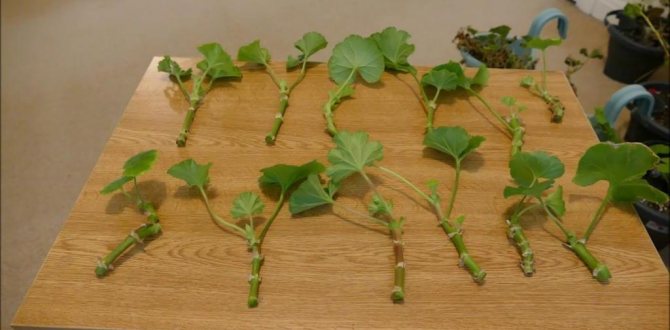

What to do after?
Dormant period
Geranium, with proper care, can bloom all summer. Therefore, she needs to provide a rest of 1.5-2 months. During this period, the plant cannot be watered and fed. If geranium is grown in the garden, then it is better to transplant it into the house for the winter.
Pruning
Experienced gardeners recommend pruning geraniums every spring. This must be done so that every year she pleases with abundant flowering. It is advisable to pinch the tops of the shoots. They are ideal for further rooting and new plants.
Transfer
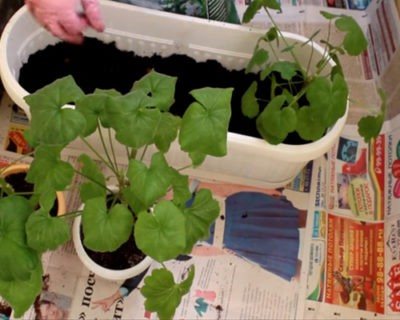

Geranium refers to plants that do not tolerate transplanting well. Therefore, it should be transplanted only in extreme cases.
- If the pot has become small and the roots are cramped in it. It is better to choose small pots, because abundant flowering can only be obtained in cramped containers.
- The plant began to wither.
- Geranium does not bloom and does not develop well.
- The roots of the flower are sticking out and bare.
Do not replant if the plant is in bloom. Instead, you can occasionally renew the topsoil.
If something went wrong
- In the first days after the start of rooting, the leaves of the cuttings wither - they need to be cut off.
- Cuttings rot at ground level - it is recommended to root them again by simply cutting off the stem to a healthy part, dry it and re-root it in new soil.
- Leaves dry and turn yellow. This may be due to a lack of moisture. To remedy the situation, you just need to increase the amount of watering.
- Geranium does not bloom. This is a consequence of improper care, namely, non-compliance with the plant regime (winter dormancy is not ensured). Another reason is that the pot is too large.
- The leaves become lethargic, rot appears on the stems - this is a sign of overflow. It is necessary to reduce watering. If this does not help, then the plant should be transplanted so that it does not die.
Over the years, geraniums gradually expose the lower part of the trunk. A fluffy dense bush with a huge number of flowering shoots suddenly turns into an ordinary stick with rarely flowering arrows. To prevent this from happening, it is necessary to properly cuttings, following all the recommendations of experienced florists.
> Useful video
In the video, we will clearly see how grafting takes place and in what ways:
Optimal growing conditions
Some growers consider geranium to be a rather capricious plant, with increased requirements for keeping conditions. Most varieties are quite mediocre in this regard and can be grown in an ordinary apartment without special care.
Did you know? Geranium has long been considered the protector of the house, and, according to popular beliefs, protects it from any evil. People still say: "Where geranium grows, there the snake will not creep."
The following indicators will be acceptable for a plant:
- Lighting - bright enough, but without direct sunlight on the leaves. A good solution would be to place the pot on the south side of the house, with temporary protection from the sun during the period of its greatest activity.
- Temperature - not lower than +12 ºC, and in winter it is advisable for the plant to choose the coolest place in the house so that in the summer it continues to delight you with lush flowering. Brief growth at reduced rates (around +10 ºC or below) will promote a wild bloom in the fall as well. Geranium is a flower that prefers coolness more, but it is impossible to lower the air temperature by spraying from a spray bottle or creating drafts.
- Air humidity - within the normal range for an average human dwelling (that is, approximately 60–75%). However, these values are not an absolute requirement for geraniums - the plant will feel great at reduced or slightly increased rates.
- Concerning soil moisture, then it is worth focusing more on the condition of the soil, watering the substrate only when the top layer dries.
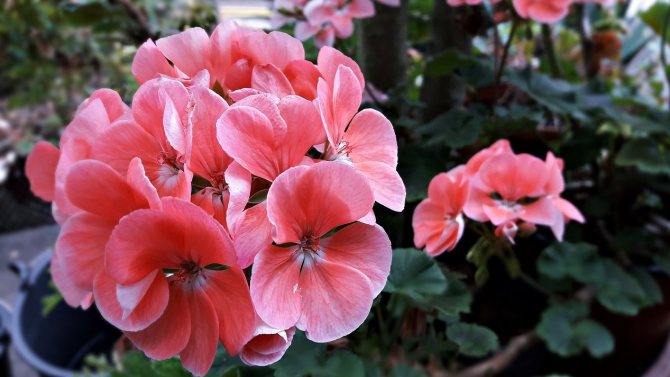

Brief description of the plant
Geranium (aka pelargonium) is a beautiful ornamental plant with a whole range of medicinal properties. This indoor flower has excellent antiseptic properties, it quickly relieves nervous tension and relieves a person of stress.
Today, there are more than ten different varietal varieties of geraniums, but all of them can be combined into several groups:
- English (scented) pelargoniums: characterized by a mint, lemon and rose aroma, which is their peculiarity;
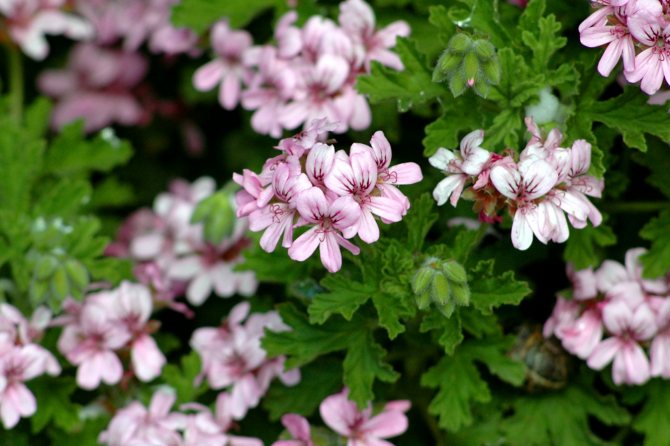

- balcony (ivy): have beautiful large flowers with wavy petals up to 6 cm in size; stems - brittle and thick, complemented by leafy plates with jagged edges;
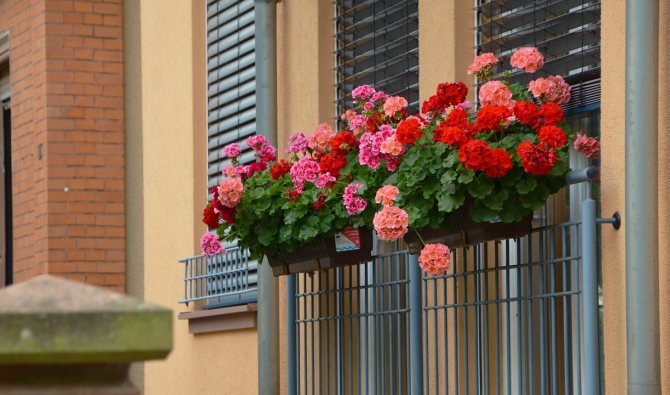

- zonal (or "standing"): with the same thick and brittle stems with rounded leaves and a horseshoe-shaped pattern; flowers are simple or double (orange, red, pink or purple shades).
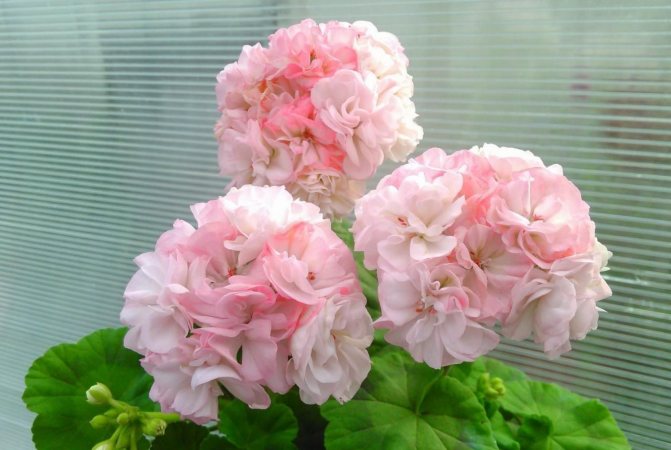

Any of these varieties will stand out against the background of other houseplants with lush flowering and bright colors, so in any case it will become an excellent decorative element of the home interior.
Possible transplant problems and solutions
The transplanted geranium is a big sissy. She is subject to many dangers. They all come from improper care of the "newborn" flower. Water the plant along the edge of the pot, not at the root. The soil must be loosened especially carefully and shallowly. The first week after transplantation for geraniums there is a dangerously active sun, it needs light partial shade.
Sometimes in pelargonium the leaves change color, lose their tone. Why does geranium turn yellow after transplanting? This is the plant's response to stress experienced. It is necessary to pinch them off and remove the inflorescences. After two to three weeks, pelargonium will return to normal. For prevention, you can pour a solution of Kornevin, Heteroauxin. They stimulate root formation.
Geranium is the favorite of many flower growers. Growing it up is not a tricky business. With proper care, an entire garden of pelargoniums can be planted. They bloom beautifully and profusely, their aroma neutralizes microbes in the room and has a beneficial effect on human life activity.
Landing features
When to plant or transplant this flower? You should be guided by two criteria:
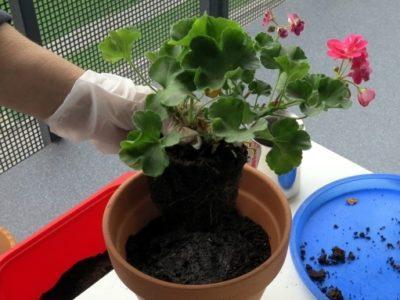

Plant appearance: if a flower grows very slowly, but at the same time proper care is taken, then this most likely means that it is time to plant it in another, larger pot.- Earth inside the pot: if, after watering has been carried out, the earth dries out quickly enough, this means that the roots of the flower have grown, and it is time to change the pot to a larger one.
There is also a universal method that will help determine whether it is time for a transplant or not. You need to get the plant out of the pot, carefully examine the lump of earth. If the roots literally penetrate the ground and there are a lot of them, then it's time to replant the plant.
Watch a video about transplanting geraniums:
General »tips
- Ideally, it is better to replant geraniums in spring.... It is imperative to prepare a larger pot in advance, into which the flower will "move".
- It is not necessary to transplant geraniums into a new pot, but it must be disinfected.... Also, for transplanting geraniums, you will need a watering can with water and fresh soil.
- Transplanting geraniums during flowering is not desirable, but you can... If possible, it is best to avoid it.
- To get a geranium out of an old pot, you must first water it.... And then you need to hold the pot with one hand and gently pull the flower with the other. As a last resort, there is an option to use a knife. With its help, you need to very carefully separate the earth from the walls of the pot.
Taking care of geraniums is not so difficult, you just need to know what this flower loves:
- Sunlight (but a light shadow is also not scary for him), he especially tolerates being on the south and east windows.
- Warm weather (but nothing will happen to the flower even with small autumn frosts).
- Watering: infrequent, but abundant.
- The pot must have good drainage.
- Interestingly, the soil should be moderately fertile, even scarce. In other cases, there will be few flowers, but a lot of greenery.
- In order for the geranium to continue to bloom, it is important to remove those inflorescences that have already faded.
- It is important to regularly feed the soil, you need to start feeding in the spring, and continue until the fall once every 2 weeks.
Tips for preparing the mother plant
When pruning a plant, when the desired shape of the crown of the bush is formed, a certain number of shoots are often left that can be used for reproduction. But in order to obtain high-quality cuttings, it is better to prepare the mother plant specially.
For reproduction, it is necessary to choose only a healthy and non-flowering plant at the age of 2-3 years. Starting to decide how to plant a geranium shoot without roots, you should first start preparing the mother plant. 2 weeks before the start of reproduction, geraniums are placed in a semi-dark place and stop watering. Instead, top dressing is carried out with a solution consisting of wood ash and water.
Considering that a geranium shoot can be planted without roots, they should be properly cut. A stalk is a part of a plant used for propagation, from which a new geranium identical to the mother will germinate in the future.
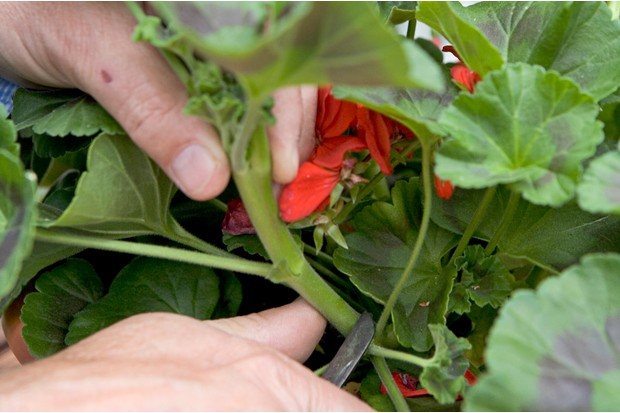

Rhizome division
In the garden and in the country, it is convenient to grow geraniums by planting rhizomes in the ground. You can buy them at specialized stores. It is recommended to purchase planting material in February. The underground part of the plant should be dense, have a firm, not withered growth point and well-developed adventitious roots. The purchased rhizome is stored in the refrigerator in a container with a moist substrate (peat) before the onset of heat. The optimum temperature of the content is + 1 ... + 2 ° С. So that the planting material does not dry out, 2 times a month it is watered with water at room temperature. Purchased plants, in which the growth of the bush has already begun, must be immediately planted in any container slightly larger than the size of the rhizome. When planting, the long roots of the plant must be carefully straightened out - they should not be confused and bent.
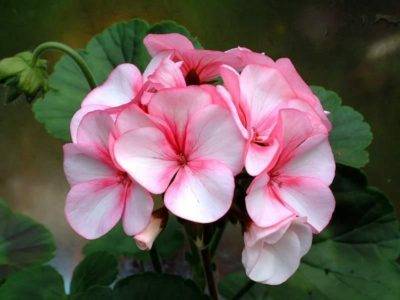

Rhizome transplantation to the site is carried out in mid-May, when the ground warms up well. Even with the slightest frost, young plants will need shelter. To do this, you need to have on hand a non-woven material - lutrasil or agrofiber.
The quick and correct formation of the geranium bush and its abundant flowering directly depend on proper planting. Pelargonium has a long root system, so the pits for it should be prepared narrow, but deep. As a rule, the longest roots should not reach the bottom about 15 cm.
Planting bushes is carried out at a distance of 30-40 cm from each other. This gap will be quite enough for the root system of the bushes to fully develop.
The planting hole is filled with a nutrient mixture mixed with sand, it is better to do this in the form of a slide, the roots of the plant are carefully laid out on top of it, then they are covered with soil and watered.
If the rhizome has several growth points, it can be divided so that each segment has at least one point and several undamaged lateral roots.
Watering is plentiful, but not excessive.
In late autumn, the rhizomes of pelargonium can be dug up, planted in suitable pots and placed in a frost-free wintering area.
Possible difficulties
Geranium is an unpretentious plant, but some problems may arise during its reproduction. So, sometimes the rooting of the cuttings does not occur in the water. Some species do not grow roots in water. You can try placing the scion in the ground. The trim should have at least two leaf nodes or one, but with a bud and heel. The water must be periodically changed by dissolving an activated carbon tablet in it. Without proper care, the stem will rot. One bud is left above the liquid level, the rest of the plant is submerged.
A florist may face other difficulties:
- The stalk does not root in the soil. There are varieties with a long rooting period, for the development of which you need to wait 1-2 months. The earth needs regular watering. The shoot should not be covered, lack of air will lead to decay and growth arrest. The planting material needs to be deepened enough, only the growth point remains on top.
- Seeds do not sprout. Planting depth should not exceed 3-4 mm, otherwise re-seeding will be required. Poor seed quality also inhibits seed growth.
- Seedlings die. The sprouts require good aeration, loose and moist soil, without an excess of water. The soil can be affected by the black leg. For prevention, you need to disinfect the seeds before sowing, ventilate the seedlings and sprinkle the soil with ash. Infected plants must be removed from the general container, water the ground with a solution of concentrated potassium permanganate and sprinkle with crushed charcoal. You can also transplant young plants into healthy soil.
- Shoots stretched out. Pelargonium requires a lot of light, so it is better to sow seeds not earlier than March or use backlighting. Alternatively, the pot is placed on the east or west window. The flower can be turned on the other side of the glass every day.
Further care
It is necessary to specially prepare the cups - to make holes in them for water drainage... In addition, due to the holes, air penetrates to the roots, which is also very good.
Next, you need to proceed according to the following instructions:
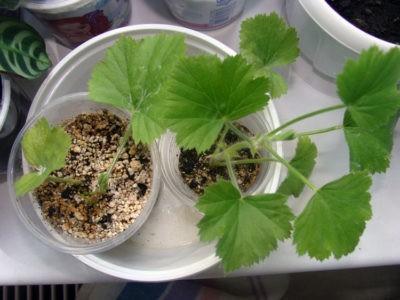

Add a little vermiculite to slightly wet, damp soil.- Fill each glass with soil,
- In the event that the land was treated with boiling water, of course, you need to wait until it cools down. Fortunately, this does not take much time. Just a few minutes.
- Place the shoots that were previously freed from the lower leaves and deepen them a few centimeters.
- Place the cups on a pallet (so that it is convenient to move them), and place for a while in a dark place,
- After 5 days, the cups need to be transferred to the window. Preferably NOT on the south side.
What if some plants have yellow, limp leaves? You can put them under the jars. That is, to create something like mini-greenhouses for them. Due to the special microclimate, the plants will recover in a couple of days..
Further care
It is necessary to specially prepare the cups - to make holes in them for water drainage. In addition, due to the holes, air penetrates to the roots, which is also very good. Next, you need to proceed according to the following instructions:
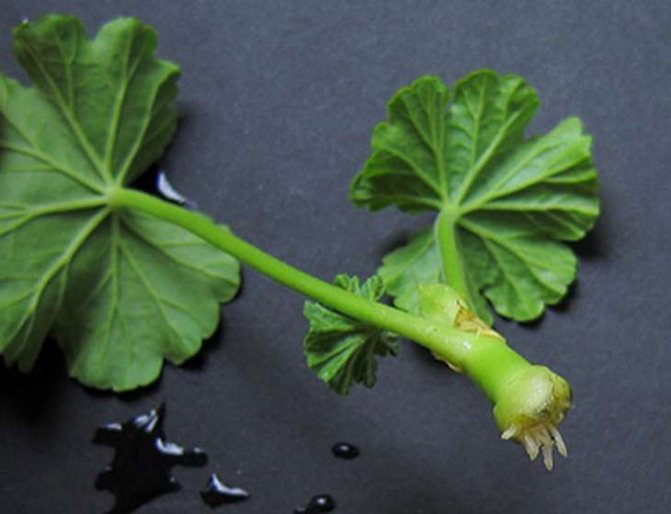

- Add a little vermiculite to slightly wet, damp soil.
- Fill each glass with soil,
- In the event that the land was treated with boiling water, of course, you need to wait until it cools down.Fortunately, this does not take much time. Just a few minutes.
- Place the shoots that were previously freed from the lower leaves and deepen them a few centimeters.
- Place the cups on a pallet (so that it is convenient to move them), and place them for a while in a dark place,
- After 5 days, the cups need to be transferred to the window. Preferably NOT on the south side.
What if some plants have yellow, limp leaves? You can put them under the jars. That is, to create something like mini-greenhouses for them. Due to the special microclimate, the plants will recover in a couple of days.
Reproduction of a plant such as geranium is a fairly simple process that anyone who takes it up can do it. And correct and timely care for a rooted plant will help it delight the eye with its attractive and aesthetic appearance.
>
Pros and cons of the method
Cutting has the following advantages:
- cuttings can be taken during planned pruning, and there is no need to additionally injure the plant;
- the qualities of the mother variety are preserved;
- in most species, the new plant develops much faster than with the seed method.
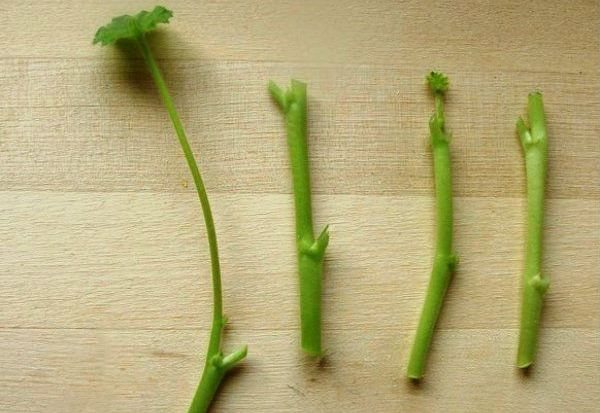

Disadvantages of the method:
- in some varieties, for example, royal or succulent geraniums, rooting is rather slow;
- during rooting, cuttings require close attention.
Output
It is an easy-care, healthy flower. Therefore, it is worth all lovers of indoor plants to have it at home. Now you know how to grow such a flower at home in a pot.
If you find an error, please select a piece of text and press Ctrl + Enter.
This beautiful plant is found in almost every home. There are many tips on how to plant and care for geraniums. But we will tell you in detail how to plant geraniums with a shoot without roots. However, despite the seeming ease of growing this beautiful plant, there are a few basic rules. Pelargonium (Pelargonium) belongs to the geranium family. Another, more familiar name for this flower is geranium. Both the names "geranium" and "pelargonium" come from the Greek language. The first of them is translated as "stork", and the second as "crane", since the shape of the fruits of plants in its appearance resembles the beak of these animals.
Preparation
Dry the cuttings in the fresh air before planting. It is enough to put them in a shaded place for a couple of hours. The damaged areas should dry out. As soon as the sections are covered with a thin film, they must be treated with an absorbent, crushed coal or wood ash.
All buds and flower arrows should be cut off from the cuttings. It is necessary to remove all leaves from the cuttings, except for one upper or side. If the leaf plate is rather large, it is recommended to cut it in half (how to propagate geranium with a leaf?). Otherwise, the cuttings of geraniums may not have enough strength to form and nourish the root system.

